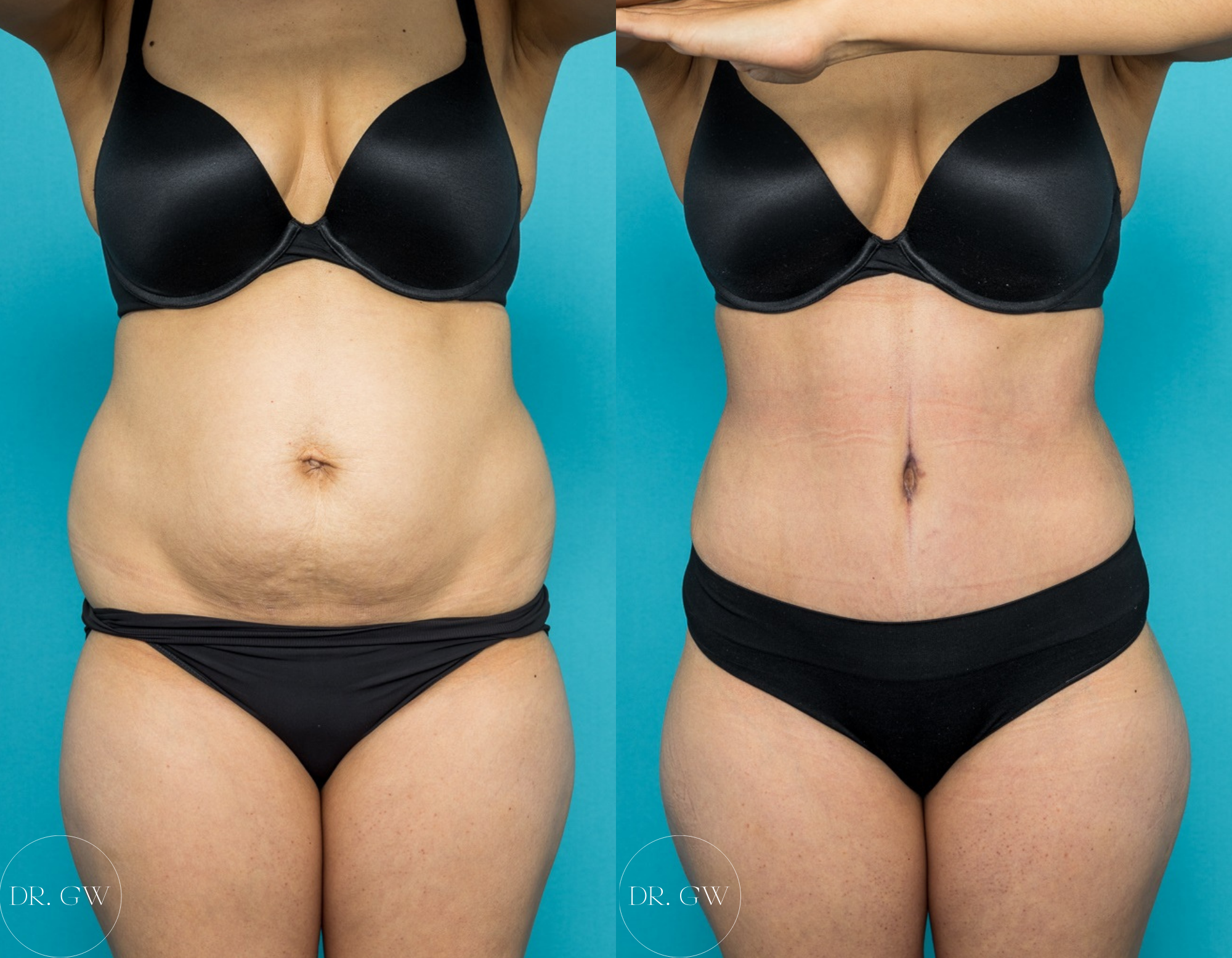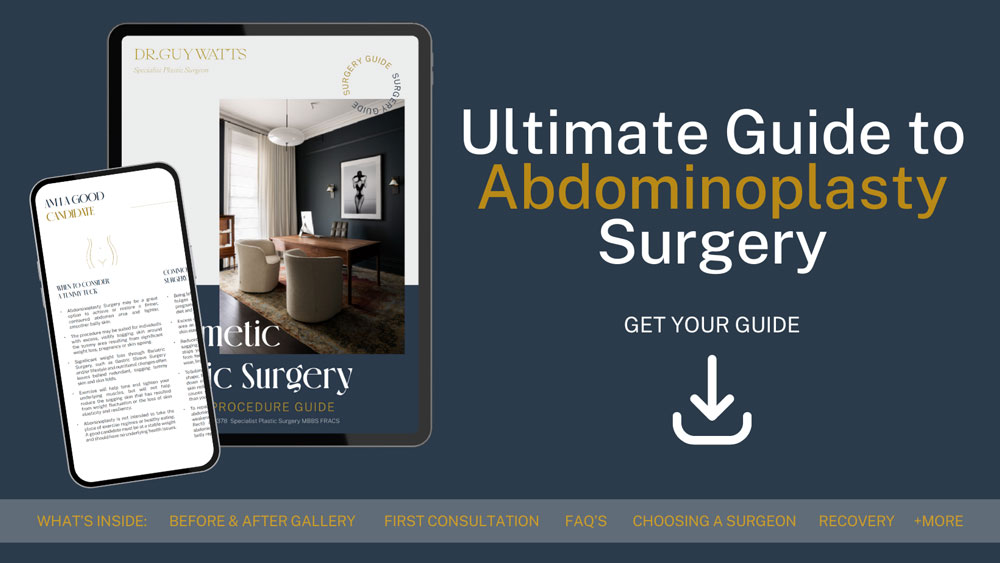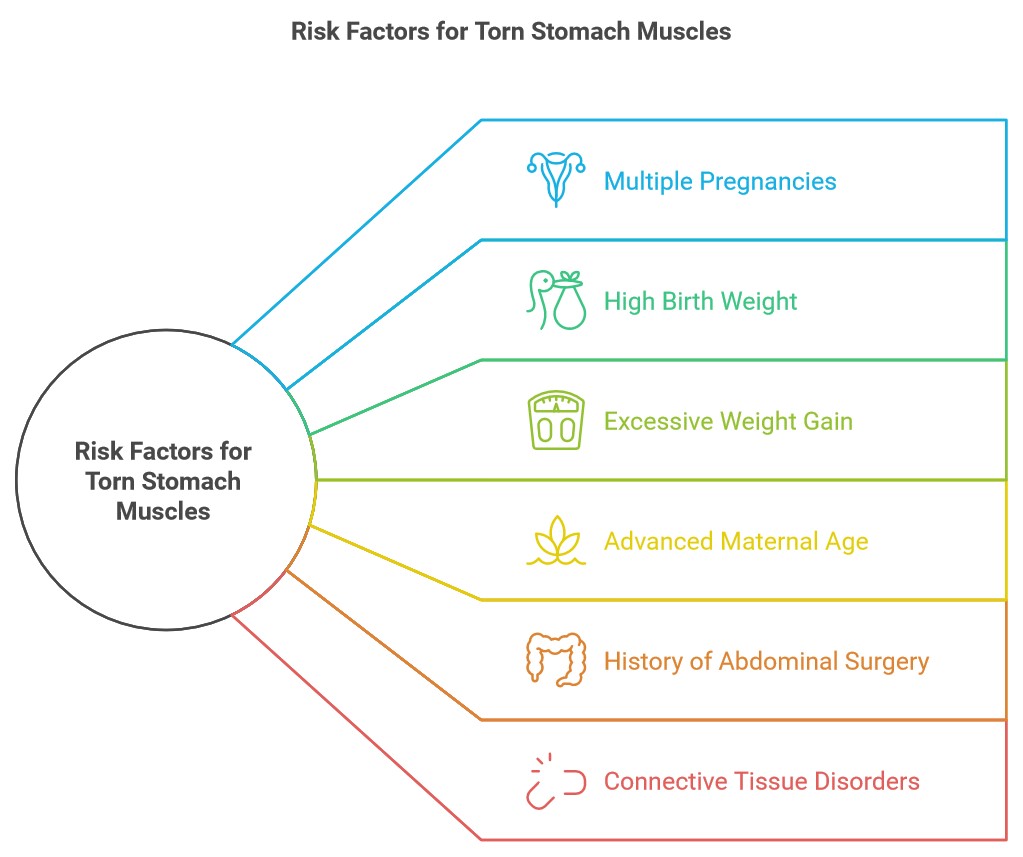
13 Jan What Do Torn Stomach Muscles Feel Like
Options for Torn Abdominal Muscles after Pregnancy
The physical changes that occur during pregnancy can lead to different post-pregnancy challenges, including torn stomach muscles. Torn stomach muscles, also known as diastasis recti, affect a number of women following pregnancy. This condition can cause discomfort, weakness, and a visible protrusion in the abdominal area. It is essential for new mothers to be aware of the symptoms and risk factors associated with torn stomach muscles, as well as the available treatment options.
Perth Specialist Plastic Surgeon Dr. Guy Watts has many years of experience performing body procedures, including abdominoplasty to repair diastasis recti.
Take our quiz, and find out if you are ready for surgery
Overview of Diastasis Recti
Diastasis recti is a condition that occurs when the rectus abdominis muscles, known as the “six-pack” muscles, separate along the midline of the abdomen. These two parallel bands of muscles, which run from the chest to the pubic bone, are connected by a thin, fibrous tissue called the linea alba. During pregnancy, the growing uterus puts pressure on the abdominal wall, causing the linea alba to stretch and the rectus abdominis muscles to separate.
When Diastasis Recti occurs
This separation is a expected occurrence during pregnancy, as it allows the abdominal wall to accommodate the growing foetus. However, in some cases, the separation may be excessive, causing a condition called diastasis recti. The separation typically occurs in the later stages of pregnancy, particularly during the third trimester, when the uterus is at its largest.
Severity of Diastasis Recti
The severity of diastasis recti can vary from woman to woman. A small separation of just a few centimetres may not cause any noticeable symptoms, while a larger separation can lead to a visible protrusion in the abdomen, as well as weakened core strength and stability. In some cases, the separation may be so severe that it causes the abdominal organs to protrude through the gap, a condition known as an abdominal hernia.
Diastasis recti can also increase the risk of developing torn or split stomach muscles after pregnancy. When the rectus abdominis muscles are separated, they are unable to function as effectively in supporting the core and maintaining proper posture. This weakness can make the muscles more susceptible to strain or tearing, especially during activities that put additional stress on the abdominal area, such as lifting heavy objects or engaging in high-impact exercise.
Torn stomach muscles can cause a range of symptoms, including pain, swelling, and bruising in the affected area. In some cases, a visible lump or protrusion may appear, indicating a more severe tear.
Risk Factors for Torn Stomach Muscles Post-Pregnancy
Different factors can increase the likelihood of developing torn stomach muscles after pregnancy.
Multiple Pregnancies
One of the most significant risk factors is multiple pregnancies. Women who have had more than one pregnancy are more likely to experience diastasis recti and consequently, are at a higher risk of developing torn stomach muscles. This increased risk is due to the repeated stretching and weakening of the abdominal muscles with each subsequent pregnancy.
High Birth Weight
Another factor that can contribute to the development of torn stomach muscles is high birth weight. Women who give birth to larger babies may experience greater strain on their abdominal muscles during pregnancy and delivery, increasing the risk of muscle separation and tearing. Similarly, women who experience excessive weight gain during pregnancy may be more prone to developing diastasis recti and subsequent torn stomach muscles.
Maternal Age
Advanced maternal age is also a risk factor for torn stomach muscles post-pregnancy. As women age, their muscles lose some of their strength and elasticity, making them more susceptible to injury. This is particularly true for the abdominal muscles, which undergo significant strain during pregnancy. Women who become pregnant later in life may be more likely to experience diastasis recti and torn stomach muscles as a result.
Other Factors
Other factors that can increase the risk of torn stomach muscles after pregnancy include a history of abdominal surgery, connective tissue disorders, and engaging in high-impact activities too soon after giving birth. Women who have had previous abdominal surgeries, such as a caesarean section or appendectomy, may have weakened abdominal muscles that are more prone to tearing. Those with connective tissue disorders, such as Ehlers-Danlos syndrome or Marfan syndrome, may also be at a higher risk due to the inherent weakness in their connective tissues.
Engaging in high-impact activities or exercises too soon after giving birth can put unnecessary strain on the already weakened abdominal muscles, increasing the risk of tearing. It is essential for new mothers to follow a gradual, guided approach to postpartum exercise and to listen to their bodies to avoid overexertion and potential injury.
Symptoms of Torn Stomach Muscles after Pregnancy
Torn stomach muscles after pregnancy can present a variety of symptoms that may be difficult to distinguish from other post-pregnancy issues. It is essential to be aware of these symptoms so you can seek appropriate medical attention and treatment.
One frequent symptom of torn stomach muscles is the presence of a visible protrusion in the stomach area. This may be more noticeable when you are standing upright or engaging your abdominal muscles. In some cases, it may be asymmetrical, with one side of the abdomen appearing more pronounced than the other.
In addition to visible changes in the abdominal area, women with torn stomach muscles may also experience weakness and instability in their core. They may find it difficult to perform everyday tasks that require abdominal strength, such as lifting their baby or performing household chores. This weakness can also lead to poor posture and balance, as the core muscles play a crucial role in maintaining proper alignment and stability throughout the body.
Diagnosis and Treatment Options
The first step in diagnosing torn stomach muscles after pregnancy is to seek professional medical advice. You should schedule a consultation to discuss your symptoms and undergo a thorough physical examination.
During the physical examination, your surgeon will assess your abdominal area, checking for any visible lumps, asymmetry, or tenderness. He may also perform a manual test to evaluate the severity of the diastasis recti, measuring the separation between the rectus abdominis muscles.
In some cases, imaging tests such as ultrasound or CT scans may be used to confirm the diagnosis and assess the extent of the muscle damage. These tests can provide a more detailed view of the abdominal wall and help rule out any other underlying conditions.
Once a diagnosis of torn stomach muscles has been made, there are several treatment options available, depending on the severity of the condition.
Treatment Options
Non-surgical Treatment
For mild to moderate cases, non-surgical treatment options are often recommended. These may include core strengthening exercises, physical therapy, and the use of supportive garments. Core strengthening exercises, such as pelvic tilts, bridges, and planks, can help rebuild abdominal strength and stability over time. Physical therapy can provide targeted guidance and support, helping women learn proper form and technique for these exercises.
Supportive garments, such as abdominal binders or compression wraps, can also be helpful in providing external support to the weakened abdominal muscles. These garments can help alleviate pain and discomfort, as well as posture issues and stability during daily activities.
Surgical intervention
For more severe cases of torn stomach muscles, surgical intervention may be necessary. The surgical procedure typically performed to alleviate this condition is an abdominoplasty. During this procedure, your surgeon will repair the separated abdominal muscles, removing any excess skin and fat in the process. This can help strengthen your core and increase stability, as well as change the appearance of the abdominal area.
It is important to note that an abdominoplasty is a major surgical procedure that requires significant recovery time. Women who undergo this procedure will need to follow a strict postoperative care plan, including rest, wound care, and gradual return to physical activity. It is essential to work closely with a plastic surgeon who has experience in treating torn stomach muscles after pregnancy to optimise outcome.
DOWNLOAD THE ULTIMATE GUIDE TO ABDOMINOPLASTY

When to Consult a Specialist Plastic Surgeon
While some cases of torn stomach muscles after pregnancy can be managed through non-surgical treatments, there are certain situations in which consulting a specialist plastic surgeon may be necessary.
If you have severe diastasis recti or torn stomach muscles that have not responded to conservative treatment options, such as core strengthening exercises or physical therapy, it may be time to seek the experience of a specialist plastic surgeon. Additionally, if you are experiencing significant pain, discomfort, or functional limitations due to your condition, a surgical consultation may be warranted.
Other situations that may benefit from the experience of a specialist plastic surgeon include women who have undergone previous abdominal surgeries, those with complex medical histories, or those who desire a more comprehensive approach to increase their abdominal strength and alter its appearance.
FAQs about Split Muscles after Pregnancy
Can I prevent diastasis recti or torn stomach muscles during pregnancy?
- While it may not be possible to completely prevent diastasis recti during pregnancy, there are steps you can take to reduce your risk. These include maintaining a stable weight, engaging in regular exercise (with your doctor’s approval), and avoiding excessive abdominal strain or heavy lifting.
- Incorporating core-strengthening exercises into your prenatal routine may also help prepare your abdominal muscles for the changes of pregnancy.
How long does it typically take to recover from torn stomach muscles after pregnancy?
- The recovery time for torn stomach muscles after pregnancy can vary depending on the severity of the condition and the treatment approach chosen.
- Non-surgical treatments like core strengthening exercises and physical therapy may show gradual changes over several weeks to months.
- If surgical intervention is necessary, recovery time may be longer, typically involving several weeks of rest followed by a gradual return to activities.
- It’s important to follow your plastic surgeon’s specific recovery guidelines to optimise healing.
Can I breastfeed if I have torn stomach muscles or if I undergo surgical treatment?
- In most cases, torn stomach muscles or diastasis recti do not directly impact your ability to breastfeed. However, if you undergo surgical treatment like an abdominoplasty, you may need to make some temporary adjustments to your breastfeeding routine.
- Your surgeon will provide specific guidelines on how to manage breastfeeding after surgery, which may include using certain positions or pillows to make sure you’re comfortable and healing properly.
- It’s important to communicate your breastfeeding goals with your surgeon so they can tailor your treatment plan accordingly.
Will my insurance cover treatment for torn stomach muscles after pregnancy?
- Medicare and insurance coverage for the treatment of torn stomach muscles after pregnancy can vary depending on the specifics of the treatment. In some cases, treatments may be covered if deemed medically necessary. However, keep in mind that surgical procedures like abdominoplasty may be considered cosmetic and therefore not covered by insurance.
Can torn stomach muscles after pregnancy recur, even after treatment?
- While treatment for torn stomach muscles after pregnancy can be effective in increasing core strength and stability, there is a risk of recurrence, especially if certain risk factors persist. These may include future pregnancies, significant weight fluctuations, or a return to high-impact activities too soon after treatment.
- To reduce the risk of recurrence, it’s important to maintain a active lifestyle, engage in regular core-strengthening exercises, and follow the recommendations for long-term management.
Further Reading about Body Procedures with Dr. Guy Watts
- Read more about Lose Weight before Plastic Surgery
- Read more about How Do I Get a Flat Stomach or Flatter Abdomen
- Read more about Benefits of Wearing Compression Garments after Abdominoplasty
- Read more about Exercise after Post Pregnancy Surgery
- Read more about Is It Diastasis Recti, Abdominal Fat, or Both?
Medical References for Diastasis Recti
- Diastasis Recti (Abdominal Separation): Symptoms & Treatment
- Abdominal Separation (Diastasis Recti)
- Diastasis Rectus Abdominis after pregnancy
- Abdominoplasty versus endoscopic approach to diastasis recti repair: A comparative study of outcomes
- Evaluation of functional outcomes following rectus diastasis repair—an up-to-date literature review
About Dr. Guy Watts – MED0001539378
FRACS (Plas) – Specialist Plastic Surgeon In Perth WA
Dr. Guy Watts is a Specialist Plastic Surgeon (AHPRA MED0001539378) with an extensive career that spans across renowned plastic surgery clinics worldwide. His experience has been honed through invaluable experiences at esteemed establishments such as the New York Eye and Ear Infirmary and the renowned Pitanguy Clinic in Brazil.
Having collaborated with the foremost cosmetic plastic surgeons on a global scale, Dr. Watts has chosen to return to Perth after a 17-year journey of intensive training and invaluable professional experience to bring the latest practices and technology in cosmetic plastic surgery to his patients.
Dr. Watts is a Fellow of the Royal Australasian College of Surgeons (FRACS) and a Member of the Australian Society of Plastic Surgeons (ASPS), Australasian Society of Aesthetic Plastic Surgeons (ASAPS) and the International Society of Aesthetic Plastic Surgeons (ISAPS).
Read about the potential Risks and Complications of Surgery
Read the Patient Information and Resources
About CLINISPA
Clinispa is Dr Watts’ bespoke medical clinic performing Cosmetic Aesthetic treatments. At Clinispa, we offer advanced clinical treatments in a luxurious and calming environment, tailored to support your skin’s health and appearance.
Clinispa aesthetic services are performed by Dr Guy Watts’ nursing professionals, who have a passion for and solid understanding of facial aesthetics.
All Clinispa clients are considered individually, with a personalised treatment plan consisting of advanced scientific approaches to cosmetic aesthetics. We incorporate innovative technologies in conjunction with superiorly formulated skin care.
For more information about the full range of Clinispa Aesthetic of Cosmetic Treatments visit the Clinispa website









Sorry, the comment form is closed at this time.